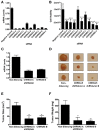Nicotinic acetylcholine receptors mediate lung cancer growth
- PMID: 24062692
- PMCID: PMC3774984
- DOI: 10.3389/fphys.2013.00251
Nicotinic acetylcholine receptors mediate lung cancer growth
Abstract
Ion channels modulate ion flux across cell membranes, activate signal transduction pathways, and influence cellular transport-vital biological functions that are inexorably linked to cellular processes that go awry during carcinogenesis. Indeed, deregulation of ion channel function has been implicated in cancer-related phenomena such as unrestrained cell proliferation and apoptotic evasion. As the prototype for ligand-gated ion channels, nicotinic acetylcholine receptors (nAChRs) have been extensively studied in the context of neuronal cells but accumulating evidence also indicate a role for nAChRs in carcinogenesis. Recently, variants in the nAChR genes CHRNA3, CHRNA5, and CHRNB4 have been implicated in nicotine dependence and lung cancer susceptibility. Here, we silenced the expression of these three genes to investigate their function in lung cancer. We show that these genes are necessary for the viability of small cell lung carcinomas (SCLC), the most aggressive type of lung cancer. Furthermore, we show that nicotine promotes SCLC cell viability whereas an α3β4-selective antagonist, α-conotoxin AuIB, inhibits it. Our findings posit a mechanism whereby signaling via α3/α5/β4-containing nAChRs promotes lung carcinogenesis.
Keywords: CHRNA5; ligand-gated ion channel; lung cancer; nicotinic acetylcholine receptor; small cell lung carcinoma.
Figures


Similar articles
-
The α3β4* nicotinic acetylcholine receptor subtype mediates nicotine reward and physical nicotine withdrawal signs independently of the α5 subunit in the mouse.Neuropharmacology. 2013 Jul;70:228-35. doi: 10.1016/j.neuropharm.2013.01.017. Epub 2013 Feb 13. Neuropharmacology. 2013. PMID: 23416040 Free PMC article.
-
α3* Nicotinic Acetylcholine Receptors in the Habenula-Interpeduncular Nucleus Circuit Regulate Nicotine Intake.J Neurosci. 2021 Feb 24;41(8):1779-1787. doi: 10.1523/JNEUROSCI.0127-19.2020. Epub 2020 Dec 30. J Neurosci. 2021. PMID: 33380469 Free PMC article.
-
β4-Nicotinic Receptors Are Critically Involved in Reward-Related Behaviors and Self-Regulation of Nicotine Reinforcement.J Neurosci. 2020 Apr 22;40(17):3465-3477. doi: 10.1523/JNEUROSCI.0356-19.2020. Epub 2020 Mar 17. J Neurosci. 2020. PMID: 32184221 Free PMC article.
-
Contribution of Variants in CHRNA5/A3/B4 Gene Cluster on Chromosome 15 to Tobacco Smoking: From Genetic Association to Mechanism.Mol Neurobiol. 2016 Jan;53(1):472-484. doi: 10.1007/s12035-014-8997-x. Epub 2014 Dec 5. Mol Neurobiol. 2016. PMID: 25471942 Review.
-
Mechanisms of Nicotine Addiction.Cold Spring Harb Perspect Med. 2021 May 3;11(5):a039610. doi: 10.1101/cshperspect.a039610. Cold Spring Harb Perspect Med. 2021. PMID: 32341069 Free PMC article. Review.
Cited by
-
α5-nAChR contributes to epithelial-mesenchymal transition and metastasis by regulating Jab1/Csn5 signalling in lung cancer.J Cell Mol Med. 2020 Feb;24(4):2497-2506. doi: 10.1111/jcmm.14941. Epub 2020 Jan 13. J Cell Mol Med. 2020. PMID: 31930655 Free PMC article.
-
Cholinergic Targets in Lung Cancer.Curr Pharm Des. 2016;22(14):2152-9. doi: 10.2174/1381612822666160127114237. Curr Pharm Des. 2016. PMID: 26818857 Free PMC article. Review.
-
Highly stable folic acid functionalized copper-nanocluster/silica nanoparticles for selective targeting of cancer cells.RSC Adv. 2020 Aug 26;10(52):31463-31469. doi: 10.1039/d0ra06523d. eCollection 2020 Aug 21. RSC Adv. 2020. PMID: 35520657 Free PMC article.
-
The Influence of Nicotine on Lung Tumor Growth, Cancer Chemotherapy, and Chemotherapy-Induced Peripheral Neuropathy.J Pharmacol Exp Ther. 2018 Aug;366(2):303-313. doi: 10.1124/jpet.118.249359. Epub 2018 Jun 4. J Pharmacol Exp Ther. 2018. PMID: 29866790 Free PMC article. Review.
-
Rare Missense Variants of the Human β4 Subunit Alter Nicotinic α3β4 Receptor Plasma Membrane Localisation.Molecules. 2023 Jan 27;28(3):1247. doi: 10.3390/molecules28031247. Molecules. 2023. PMID: 36770914 Free PMC article.
References
LinkOut - more resources
Full Text Sources
Other Literature Sources
Research Materials

